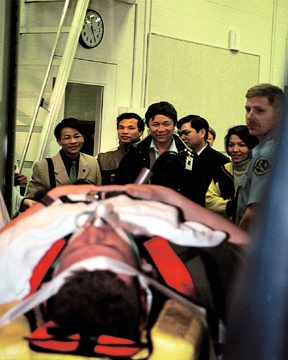Five Vietnamese doctors came to Whidbey Island this week as part of a sight-seeing tour of a different kind.
Cameras weren’t focused on tourist attractions, and the trip wasn’t for fun and games. From the time they stepped off the plane in Seattle on Jan. 11, the doctors were eager to head for the hospitals.
A delegation of five doctors from the Municipal Health Department of Hanoi arrived to research area medical facilities in an attempt to improve emergency medicine in their country.
Tuesday and Wednesday, the fact-gathering group stopped at Whidbey General and its Emergency Medical Services station in Oak Harbor.
“The main goal of the visit is for the doctors to learn more about organizing an ambulance system, especially the training aspects as regards to pre-hospital care,” said delegation host Dr. Charles Mock, Surgical and International Public Health Professor at the University of Washington.
Grant money from the U.S. Agency for International Development (USAID), a branch of the U.S. State Department, made the visit possible.
USAID wanted to be able to show the visiting doctors rural as well as major metropolitan emergency medical systems. While in Seattle for two weeks, the doctors visited Harborview Trauma Center and Medic One, as well as other EMS offices in the Puget Sound area.
Doctors Paul Zaveruha of Coupeville and Charles Mock have known each other for ten years, having both been involved with the Surgery and Public Health Departments at the University of Washington. Also, they both remain active in state and national injury prevention activites. The decade long, intertwining paths of study and practice led grant applicant Mock to suggest USAID consider Zaveruha and Whidbey Island. In the end, Whidbey General was chosen.
“We were proud to be chosen by USAID because there are a number of rural EMS systems in the Puget Sound area, so to be chosen was a real honor,” said Roger Meyers, Island County EMS manager.
Hanoi has only one ambulance station. The single station and its ten ambulances are responsible for 3 million people. This means less than 20 percent of patients arrive at a hospital via ambulance. The remainder arrive by taxi, rickshaw, foot or bicycle. This compares to Whidbey Island where a population of roughly 60,000 people is served by 12 ambulances.
“To create an emergency medical system that mimics one like Whidbey General’s is very achievable for them,” Meyers said. “Hanoi is very high in population like Seattle, but once you go past the asphalt and concrete of the city it’s rural like much of Whidbey.”
In Vietnam, 30 people die each day from injuries sustained in automobile accidents. As in the U.S., this is only one of many reasons people need ambulance service.
According to Dr. Nguyen Hoang, fourth-year medical student at the University of Washington and acting interpreter for the visiting doctors, factors that have attributed to the growing need to create an EMS system in Vietnam include population growth, traffic growth, and construction and development.
“The hospitals in Vietnam are actually very state-of-the-art in their ICU and other departments, but once you look at the emergency medicine aspect — that’s the missing link,” Meyers said. “It’s the care of the patients and the getting them to the hospitals that’s the problem.”
At the EMS station in Oak Harbor, the doctors learned that the estimated time of arrival by essential emergency vehicles to a car accident in Island County is under eight minutes. In Hanoi, the average is 30 minutes.
Ambulances in Vietnam are manned by a doctor, a nurse and a driver. On Whidbey the standard is one paramedic and an EMT per emergency vehicle.
After returning to Vietnam, the visiting doctors hope to establish a training system for emergency medical technicians and paramedics.
While at the EMS station, the visiting doctors were given a glimpse how Island County EMS would handle an emergency. A group of EMTs and paramedics ran through different call scenarios while the doctors watched every detail with interest.
Later, the Vietnamese doctors visited a good example of one of the goals they hope to achieve — a modern emergency communications system like I-COM, the communications headquarters for Island County’s law enforcement, fire and medical systems.
Currently, ambulance personnel in Vietnam have no means of notifying hospitals enroute of the status of the patients they transport. There is no inter-agency communication between the ambulances and the hospitals or fire departments.
Dr. Phung Minh Van faces this challenge every day. She is a doctor in the Emergency Department at Dong Da Hospital in Hanoi. The lack of communication between the ambulance system and the hospitals often compounds the already hectic trauma situations, she explained.
Wednesday, the delegation visited Whidbey General’s Emergency Room and other departments that swing into action when an ambulance arrives. Despite the construction sprinkled through the hospital, the doctors were obviously impressed as they visited WGH’s ER, Surgical Department, Intensive Care Unit, Maternity Ward, Records Department, and various others. No aspect of emergency and trauma medicine was ignored.
Having visited hospitals, medical facilities and toured EMS systems of various sizes in countries such as France, Singapore and Korea, the visiting doctors were surprised to see that a rural hospital the size of Whidbey General was able to set and maintain such a standard.
When asked if there was anything about the EMS systems that they’ve visited in the United States that they’d change, Dr. Nguyen Xuan Binh, senior ambulance doctor for the Hanoi Emergency Transport Center, responded, “When we get as good, we’ll make suggestions.”


